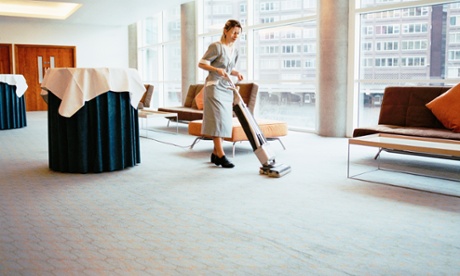
In February, California’s legislature began considering AB 708, a bill that would require cleaning product manufacturers to disclose all ingredients on product labels. Although the bill doesn’t directly address female exposure to chemicals, if it passes, it could have had significant and wide-ranging impacts on women – the primary users of cleaning products.
While gender roles have changed in the last few decades, a 2014 survey by the US Bureau of Labor Statistics shows that women still perform about 55-70% of household cleaning, about 30% more of the cleaning than men. In addition to eating up time, this extra work could leave women more susceptible to any negative impacts of chemicals in cleaning products.
Professionally, the gender difference in cleaning is even more stark: 89% of home and hotel cleaners – whose exposure to these chemicals is quadrupled – are women. The majority of those women are minorities, according to the most recent US Bureau of Labor Statistics data.
Demand for green cleaners
When it comes to chemical exposure, women are flying blind. Some companies voluntarily disclose the ingredients in their cleaning products, and some states are beginning to consider regulations that would require more explicit labeling. However, there are no federal laws on the books that require companies to list the ingredients in their cleaning products.
Not surprisingly, many consumers, particularly women, are increasingly buying green cleaners. Between 2007 and 2011, retail sales of green cleaners more than doubled, going from $303m annually to $640m, according to market research firm Packaged Facts. In 2013, Walmart followed the trend, launching Great Value Naturals, a new line of “all natural” cleaning products.
To capture the burgeoning natural cleaning market, more companies are producing green cleaning products and disclosing ingredients, either on labels or on their websites. Several have also launched ingredient-screening programs, showcasing lists of safe ingredients on their websites.
But green cleaners don’t always live up to the hype. In Deep Clean, a report released this week on cleaning products, nonprofit Women’s Voices for the Earth (WVE) noted that many companies are not disclosing the criteria they use for evaluating the ingredients that they deem “green”. The group reported, for example, that independent lab testing has uncovered that SC Johnson’s cleaning products contain synthetic musk, a known endocrine-disrupting chemical.
Still, Deep Clean give SC Johnson its highest score: it tied with Clorox for a B-, thanks to its efforts to both disclose ingredients (this year it became the first company to begin disclosing fragrance ingredients) and respond to consumer concerns. Its top competitor, Procter and Gamble, on the other hand, scored an F.
The American Cleaning Institute (ACI), a trade group representing cleaning product manufacturers, claimed that Deep Clean failed to take into account the industry’s efforts at consumer protection. “It ignores the fact that an enormous amount of resources are dedicated to assuring the safety of products, including significant investments in research, development and testing before products ever hit the shelves,” ACI said in a statement.
But while ACI called its members’ safety screening process “rigorous” and touted their efforts to “share more information than ever about ingredients”, WVE was not convinced. The group says that a rigorous screening process wouldn’t let hormone-disrupting chemicals through, and adds that companies need to be completely transparent about their products.
California cleans house
When California’s legislature announced plans to review AB 708, the cleaning product labeling bill, public health advocates were quick to offer their support. They decried the health impacts of cleaning products and touted consumers’ and workers’ right to know what’s in their products.
On the other side, ACI opposed the bill, stating that several other state and federal regulations already do or will require labeling of ingredients of concern. Moreover, ACI claimed, requiring companies to list every single ingredient – irrespective of its relevance for health – would not be of value to consumers.
“Some products may have hundreds of ingredients in tiny amounts,” the group wrote in its opposition. “The broad requirement of AB 708 to list all ingredients on the label is likely to frustrate the goal of enhancing consumer protection.”
Once again, ACI touted the chemical industry’s voluntary labeling efforts. It drew attention to the Consumer Product Ingredient Communication Initiative, an industry program that aims to communicate ingredients to consumers. Under the initiative, ACI explained, participating consumer cleaning product manufacturers list all ingredients except those that they determine “incidental”.
AB 708’s sponsors – nonprofit environmental health organizations Breast Cancer Fund and Environmental Working Group – disagree with ACI. In public comments on the bill, Nancy Buermeyer, senior policy strategist for the nonprofit Breast Cancer Fund, wrote that voluntary labeling is not sufficient to educate the “disproportionately low-wage workers, women, immigrants and people of color” who work with many “complex and often hazardous cleaning solutions”.
• This article is part of a series about women’s health and chemicals.

